Author: Mu Mu, Baihua Blockchain
Since this round of market sentiment, Bitcoin has been singing high, making Ethereum and some old "value projects" increasingly powerless, with the ETH/BTC ratio once hitting bottom, which has become the strongest "unsatisfied" of a group of veteran cryptocurrency enthusiasts, unparalleled. Both bull and bear markets have gone through, but they have always been unable to let go of the stagnant ETH, and the dissatisfaction of the cryptocurrency community with ETH seems to have reached its peak.
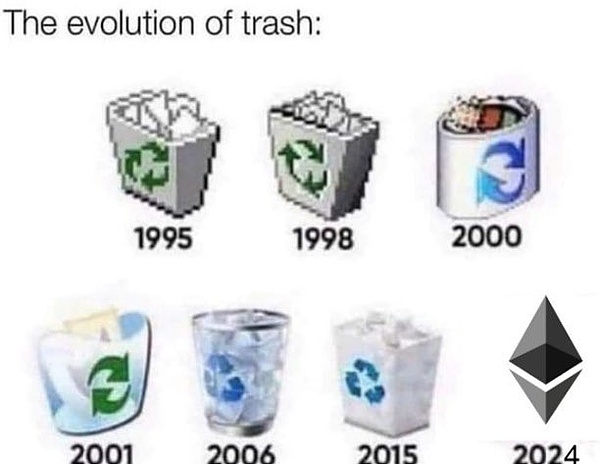
The cryptocurrency community has started to circulate a large number of sarcastic images targeting Ethereum
01 Has the original intention of Ethereum changed?
Although ETH and BTC have different paths and there is not much direct conflict, but since the bear market began, most of the people who hold ETH for the long term have hoped that ETH can outperform BTC, that is, ETH/BTC can have a good return. According to the experience of the previous bear market, ETH is mostly able to outperform BTC.
Similar to the mentality of the Ethereum community holders wanting to outperform BTC, the original intention or differentiation development strategy of Ethereum is to take a path that the Bitcoin community has not taken and believes is not good: a blockchain-based smart contract application platform, and plans to explore blockchain expansion to bring scalability and performance, developing decentralized applications beyond digital gold.
Similar to some "altcoin" projects that appeared at the time, they all wanted to improve on Bitcoin, with a differentiation strategy or to become a more successful Bitcoin.
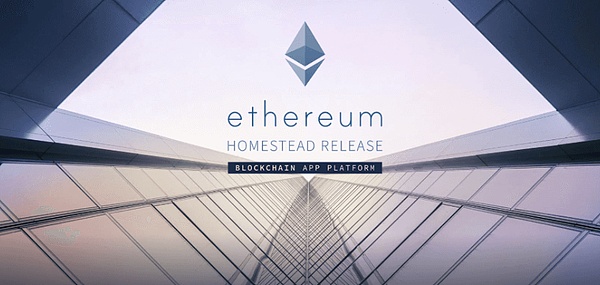 Previous screenshot of the Ethereum Foundation's official website
Previous screenshot of the Ethereum Foundation's official website
If early cryptocurrency users have been paying attention, they must have seen the background image of the Ethereum Foundation's official website above, which looks "very ambitious", with a clear slogan written on it: Blockchain Application Platform, which was the most accurate positioning of Ethereum by the Ethereum community at the time, and the background image seems to be a high-rise building springing up, or foreshadowing the expansion and construction of the blockchain.
Now, some people believe that the original intention of Ethereum has changed, since Ethereum's consensus mechanism has undergone the POS merger, perhaps due to the inability to rise in price, they attribute Ethereum's decline to the POS formula mechanism, believing that the huge shift from POW to POS is a huge mistake. But in fact, the transition of Ethereum to POS has been in the early roadmap, and is not a last-minute change, it is a choice and plan made under the demand for account model blockchain expansion and extension of the smart contract public chain platform.
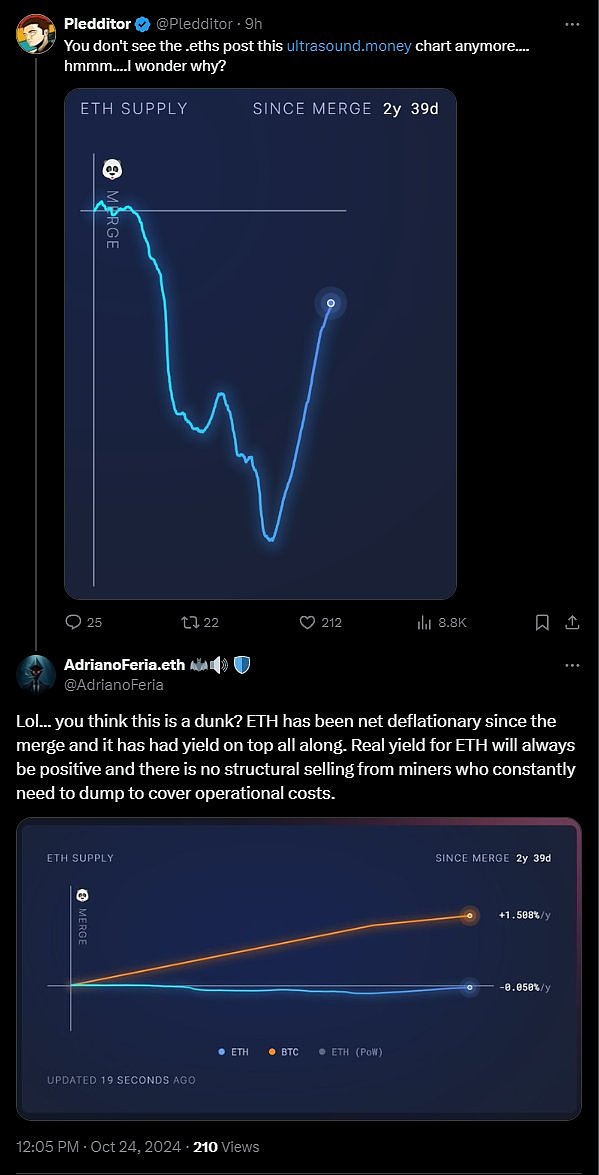
Recently, a major Bitcoin supporter on social media has released a chart of Ethereum's inflation rate trend after the merger, showing that Ethereum's inflation rate has risen rapidly in the past half year, trying to prove the wrong path of Ethereum's merger. But the counterattack came quickly, with Ethereum community users publishing the full picture of this statistical trend, along with a comparison of Bitcoin's annual inflation rate (the ratio of new issuance to circulating supply), making the picture even clearer.
Many people used to sneer at Ethereum's unlimited issuance, believing that Ethereum would issue an unlimited amount, but the real situation now is that Ethereum has not only not affected security through the POS merger and EIP1559, but has also controlled inflation, far lower than Bitcoin's current inflation rate, and has pulled away from other well-known POS public chains.
Ethereum has firmly taken the second throne in Crypto, and has also become the "differentiation object" of many new public chain projects, with many projects also aiming to become a better "Ethereum". It can be said that the Ethereum roadmap has not undergone major changes apart from adjustments to the implementation details, and the original vision has also been gradually realized.
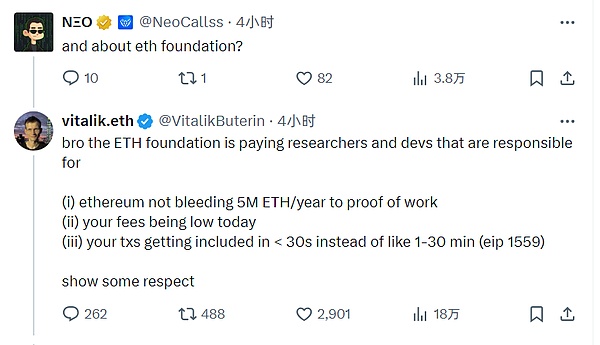
Recently, Vitalik responded on social media to the criticism of the Foundation's outflows, accompanied by 9 pieces of information related to the Ethereum fundamentals.
Vitalik:
The Ethereum Foundation is paying researchers and developers to work on
(1) No longer losing 5 million ETH per year to the Proof-of-Work (POW) mechanism
(2) Your current fees are very low
(3) Your transactions will be packaged in < 30 seconds, not 1-30 minutes (eip-1559)
(4) zk technology allows people to maintain privacy while using ETH
(5) Account abstraction technology will allow ordinary people to use ETH safely without seed phrases or SBF-style centralized failure points
(6) Local ETH activities around the world, many of which hardly mention the Foundation's name
(7) ETH has never gone offline due to DoS attacks and consensus failures since 2016
(8) Various security work (internal development and grants) has prevented many fund losses
(9) The libraries used in the various codes you use (wallets, DeFi applications, etc.)
From another perspective, the reason why Ethereum exists and is endowed with a market capitalization of over $300 billion may not be solely due to the amount of Gas fees it captures, but more due to its expansion and innovation in the cryptocurrency field, continuously accepting the value spillover from Bitcoin. So in the previous two bull markets (2018 and 2021), the ETH/BTC ratio has risen relatively, which is one of the main underlying logics for Ethereum's long-term outperformance.
In this round of the big bull market, although Ethereum's fundamentals are good, the author finds that many people only mention the problems of fragmented on-chain liquidity in the Ethereum ecosystem and the competition from new public chains, while ignoring the most important thing, which is Ethereum's ecosystem's acceptance of Bitcoin's value spillover.
02 Are the unresolved problems of Bitcoin an opportunity for Ethereum?
In design, Bitcoin is undoubtedly a "god-level" work, but such a system does not mean "perfect in every way", after all, many project designs want everything and cover everything, seemingly perfect but actually complex and full of loopholes, difficult to break through quickly.
Satoshi Nakamoto has left some unresolved problems or regrets for Bitcoin for later generations to optimize. For example, the contradiction between the ever-decreasing issuance and the development of the ecosystem threatens the sustainability of the Bitcoin system.
Simply put, the ever-decreasing inflation rate in the process of Bitcoin's continuous halving will drive the scarcity of Bitcoin to become a favorable factor for price appreciation, but this may not be the case for the Bitcoin system, because the halving is bound to lead to a decrease in the income of POW miners, which may also reduce the enthusiasm of miners, and in turn may affect the security and stability of the system.
Of course, the Bitcoin community has also proposed a solution, which is to develop the Bitcoin ecosystem, so that when the future halving leads to insufficient miner income, the prosperity of the Bitcoin ecosystem can make up for the reduction in system rewards, and continue to motivate miners to provide strong system protection. This is also drawing on the experience of the Ethereum community's blockchain expansion route. But the high price and transaction fees, and the low efficiency of the mainnet, have posed a considerable challenge to the sustainable development of the Bitcoin ecosystem.
The problems of Bitcoin have always been on the "table", and the only solution is to keep Bitcoin rising, then there will be no problem, but obviously this is unlikely, so when capital pushes Bitcoin to the vicinity of the bottleneck, the value will spill over to other blockchains. At present, the only large-scale project that can bear most of Bitcoin's value spillover is Ethereum, there is no other.
03 Bitcoin L2 and Ethereum L2 are in the same boat
The development of the Bitcoin ecosystem is now in full swing, with many teams bringing a lot of expansion solutions, especially borrowing from Ethereum's Layer2 solution, it can be said that Ethereum's leading exploration of Layer2 is guiding the expansion solutions of Bitcoin Layer2. Bitcoin Layer2 and Ethereum Layer2 are converging, and some even say that Ethereum is the largest testnet for Bitcoin.
Of course, the current Bitcoin Layer2 still faces some challenges, such as the difficulty in inheriting Bitcoin's security, and the slow block generation speed of Bitcoin itself, which affects the settlement efficiency of Layer2 transactions, etc. Therefore, if the idle BTC wants to participate in DeFi, it will still choose to cross to the Ethereum chain to obtain reliability and security.
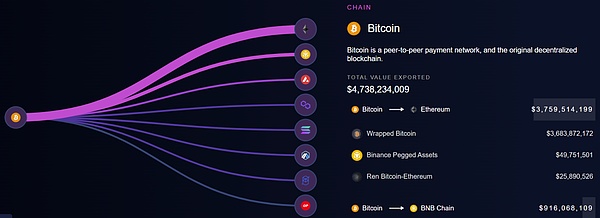 Source: CryptoFlows
Source: CryptoFlows
According to CryptoFlows data, Bitcoin has exported about $3.8 billion in assets to Ethereum mainly through stablecoin bridges, not including Layer2, and the inflow to the Ethereum mainnet accounts for the vast majority of Bitcoin's cross-chain output, indicating the recognition of on-chain funds for Ethereum. In the future, with the continuous development of BitcoinFi, the Ethereum ecosystem will inevitably receive more inflows.
In fact, from another perspective, in the era of multi-chain interconnection and chain abstraction of large-scale Web3 applications, the interconnection and seamless interoperability between the crypto big ecosystems, Ethereum is perhaps on the way to becoming the largest sidechain or the generalized Layer2 of Bitcoin? The best DeFi protocols in the Ethereum ecosystem are helping to activate the dormant Bitcoin funds.
Whether it is an expansion solution on the same boat or the cross-chain flow of funds, the future of Bitcoin and Ethereum seems to be increasingly intertwined.
04 Summary
From the current perspective, Ethereum's original intention has not changed, and what it is supposed to achieve has also been achieved, the only change is due to the "fickle" holders who cannot resist the temptation. Against the backdrop of tightening global liquidity, the crypto narrative is shrinking, and chasing memes is understandable (the economy is bad, so people gather at the village entrance to try their luck), but the upcoming global rate cut cycle that will gradually release liquidity may bring about a change, don't forget that the adoption of crypto assets and the landing value of Web3 applications will eventually return.
As the number one and number two crypto assets, the future intertwined Bitcoin and Ethereum are not in an antagonistic relationship, nor is it a simple black and white situation. The crypto community, regardless of which camp they stand in, should stop internal consumption and "breaking the pot while eating" behavior, and march together towards the next generation of the Internet with large-scale adoption. Hopefully the other ETHs will not disappoint going forward.







